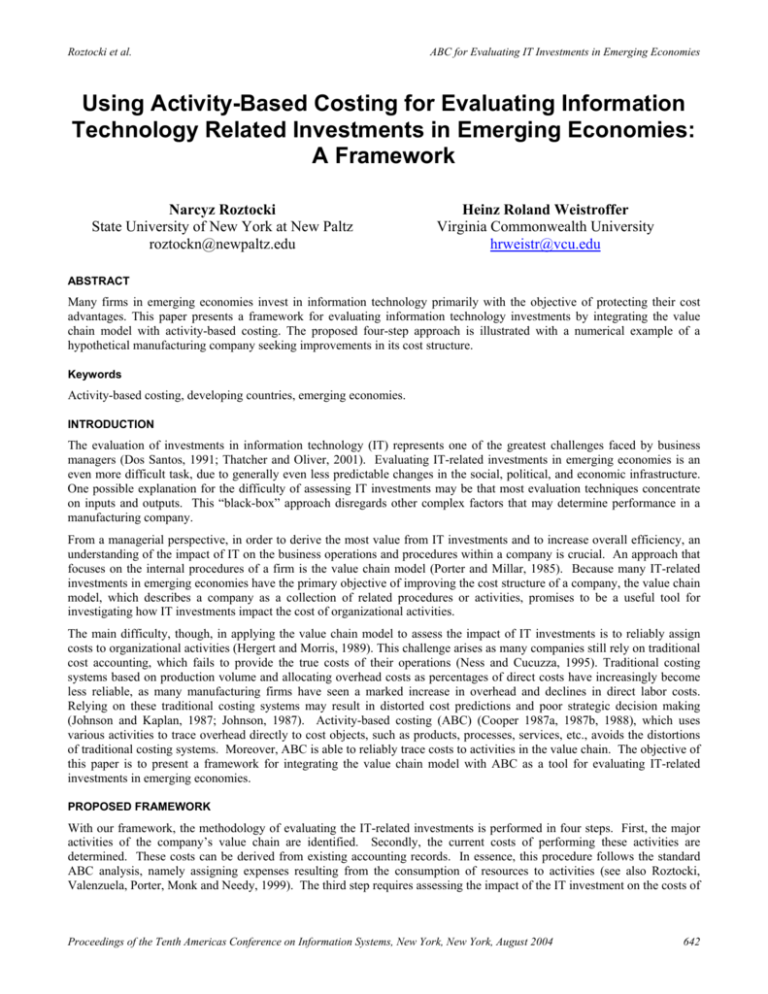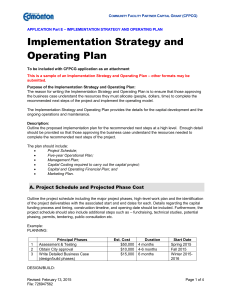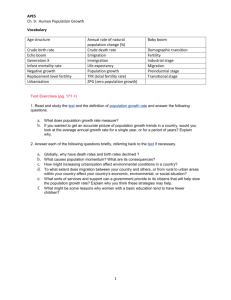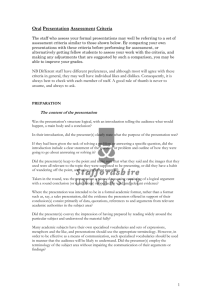Using Activity-Based Costing for Evaluating Information Technology
advertisement

Roztocki et al. ABC for Evaluating IT Investments in Emerging Economies Using Activity-Based Costing for Evaluating Information Technology Related Investments in Emerging Economies: A Framework Narcyz Roztocki State University of New York at New Paltz roztockn@newpaltz.edu Heinz Roland Weistroffer Virginia Commonwealth University hrweistr@vcu.edu ABSTRACT Many firms in emerging economies invest in information technology primarily with the objective of protecting their cost advantages. This paper presents a framework for evaluating information technology investments by integrating the value chain model with activity-based costing. The proposed four-step approach is illustrated with a numerical example of a hypothetical manufacturing company seeking improvements in its cost structure. Keywords Activity-based costing, developing countries, emerging economies. INTRODUCTION The evaluation of investments in information technology (IT) represents one of the greatest challenges faced by business managers (Dos Santos, 1991; Thatcher and Oliver, 2001). Evaluating IT-related investments in emerging economies is an even more difficult task, due to generally even less predictable changes in the social, political, and economic infrastructure. One possible explanation for the difficulty of assessing IT investments may be that most evaluation techniques concentrate on inputs and outputs. This “black-box” approach disregards other complex factors that may determine performance in a manufacturing company. From a managerial perspective, in order to derive the most value from IT investments and to increase overall efficiency, an understanding of the impact of IT on the business operations and procedures within a company is crucial. An approach that focuses on the internal procedures of a firm is the value chain model (Porter and Millar, 1985). Because many IT-related investments in emerging economies have the primary objective of improving the cost structure of a company, the value chain model, which describes a company as a collection of related procedures or activities, promises to be a useful tool for investigating how IT investments impact the cost of organizational activities. The main difficulty, though, in applying the value chain model to assess the impact of IT investments is to reliably assign costs to organizational activities (Hergert and Morris, 1989). This challenge arises as many companies still rely on traditional cost accounting, which fails to provide the true costs of their operations (Ness and Cucuzza, 1995). Traditional costing systems based on production volume and allocating overhead costs as percentages of direct costs have increasingly become less reliable, as many manufacturing firms have seen a marked increase in overhead and declines in direct labor costs. Relying on these traditional costing systems may result in distorted cost predictions and poor strategic decision making (Johnson and Kaplan, 1987; Johnson, 1987). Activity-based costing (ABC) (Cooper 1987a, 1987b, 1988), which uses various activities to trace overhead directly to cost objects, such as products, processes, services, etc., avoids the distortions of traditional costing systems. Moreover, ABC is able to reliably trace costs to activities in the value chain. The objective of this paper is to present a framework for integrating the value chain model with ABC as a tool for evaluating IT-related investments in emerging economies. PROPOSED FRAMEWORK With our framework, the methodology of evaluating the IT-related investments is performed in four steps. First, the major activities of the company’s value chain are identified. Secondly, the current costs of performing these activities are determined. These costs can be derived from existing accounting records. In essence, this procedure follows the standard ABC analysis, namely assigning expenses resulting from the consumption of resources to activities (see also Roztocki, Valenzuela, Porter, Monk and Needy, 1999). The third step requires assessing the impact of the IT investment on the costs of Proceedings of the Tenth Americas Conference on Information Systems, New York, New York, August 2004 642 Roztocki et al. ABC for Evaluating IT Investments in Emerging Economies each activity over a specific time period. This necessitates making assumptions as to specific cost savings due to such things as possibly reduced labor needs, streamlined workflows, better decision making information, etc. Finally, the fourth step is to estimate the projected future costs and to assess the expected improvement in the cost structure. Figure 1 illustrates these steps and their inputs and outputs. Value Chain Step 1 Identify Activities Accounting Records Step 2 Major Activities Assign Costs to Activities Proposed IT Investment Step 3 Current Cost Structure Estimate Impact of IT on Activity Costs Step 4 Projected New Cost Structure Evaluate New Cost Structure Investment Decision Figure 1: Four-Step Method A systematic approach to this evaluation could be a comparison between the projected costs for activities without the IT investment and with the IT investment, over a specific time period, as shown in Figure 2. The expected potential savings could then be compared to the additional expenses related to this IT investment. Projected Costs after 1 Year Projected Costs after 2 Years Projected Costs after 3 Years projected activity 1 cost projected activity 2 cost projected activity 3 cost etc. projected activity 1 cost projected activity 2 cost projected activity 3 cost etc. projected activity 1 cost projected Activity 2 cost projected Activity 3 cost etc. Projected Costs after 1 Year Projected Costs after 2 Years Projected Costs after 3 Years projected activity 1 cost No IT Investment projected activity 2 cost projected activity 3 cost etc. projected activity 1 cost projected activity 2 cost projected activity 3 cost etc. projected activity 1 cost projected Activity 2 cost projected Activity 3 cost etc. IT Investment Current Costs activity 1 cost activity 2 cost activity 3 cost etc. Figure 2: Projecting Costs ILLUSTRATION Since the objective of this section is to exemplify the IT investment evaluation framework, simplified accounting data are used. The numbers for real companies may vary substantially due to specific company characteristics, the industry, and the geographical location. However, this will not change the procedure proposed in our framework. Let us consider a small manufacturing company (a fictitious firm, but a realistic representation of many businesses in developing countries) which is a supplier to a number of large companies exporting mainly to the North American market. Because one of the main motivations to outsource in emerging economies is the cost advantage, the company is highly concerned about its expenses. It is feared that if the manufacturing company loses its ability to deliver acceptable quality products at low prices, the exporting companies will shift their outsourcing orders to less expensive competitors. With the current level of sales and expenses, the manufacturing company is able to make a marginal profit. However, it is expected that within the next three years the total costs will substantially increase for various reasons, such as rising salary levels and environmental and legal requirements. In addition, there is increasing pressure to move from simple but laborintensive manufacturing processes to more complex ones, which is expected to result in higher expenses for engineering. Sales, however, are not rising as fast as costs, due to competitive pressures. An overview of the current annual expenses compared to the projected cost structure in three years is given in Table 1. Proceedings of the Tenth Americas Conference on Information Systems, New York, New York, August 2004 643 Roztocki et al. ABC for Evaluating IT Investments in Emerging Economies Cost Type Direct Cost Operating Cost Capital Cost Total Cost Current Level $500,000 $300,000 $200,000 $1,000,000 Projected after Three Years $800,000 $800,000 $400,000 $2,000,000 Change +60.0% +166.7% +100.0% +50.0% Table 1: Current Cost Structure versus Projected Cost Structure after Three Years The most substantial increase can be seen in operating expenses, which are projected to more than double in size, and are expected to make up approximately 40 percent of the total expenses. Ultimately, the operating cost could be expected to increase even further and become the largest portion of the overall costs (many manufacturers in developed countries, show operating expenses of 70 percent and higher (Miller and Vollmann, 1985)). In order to transform the aggregated view of operating costs into more useful information for decision-making, ABC can be employed. This analysis involves identifying the major business activities and assigning costs to these activities. Our example portrays ten major activities. In general, when implementing ABC in an organization, it is reasonable to start with a relatively simple representation with only a few activities (Needy, Nachtmann, Roztocki, Colosimo Warner and Bidanda, 2003). Subsequently, in order to increase the accuracy of the cost management system, additional activities can be introduced, or complex activities can be split into sub-activities. The current costs for each activity are used to derive estimates for costs after three years. Table 2 summarizes the expected (hypothetical) expenses for carrying out the major business activities. Activity Receive Orders Schedule Jobs Purchase Materials and Subparts Handle Inventory Manage Production Assure Quality Ship Final Products Administrate Payments Perform Engineering Work Manage Customers Total Current Operating Cost $30,000 $20,000 $30,000 $30,000 $60,000 $10,000 $50,000 $20,000 $20,000 $30,000 $300,000 Projected Operating Cost $60,000 $50,000 $80,000 $70,000 $160,000 $30,000 $100,000 $40,000 $110,000 $100,000 $800,000 Table 2: Current and Projected Operating Costs by Activity In order to slow the increase in operating costs, the company examines the possibility of investing in a new IT system to automate and streamline many of the activities currently performed manually, such as job scheduling. This system is expected to substantially decrease the cost of many of the business activities and thereby lower operating expenses. For the purpose of this illustration we assume that the proposed IT investment will reduce the overall operating expenses by 25 percent. (In reality, this figure can vary substantially. Many IT investments produce only modest cost savings while others may deliver substantially better savings.) Table 3 compares the projected activity costs after three years with and without the proposed IT investment. Due to the proposed IT investment, the total overhead costs are expected to be 25% less at $600,000. This kind of information derived by using ABC will allow managers to decide if the proposed IT investment is cost effective. However, when projected cost savings are expected to be modest, management may consider other, less tangible benefits of the proposed IT investment, such as increased flexibility. CONCLUSIONS AND LIMITATIONS The paper discusses the complex issue of evaluating IT investments in emerging economies. The major contribution of this paper to the field of technology management lies in the integration of the value chain model with ABC for the purpose of evaluating IT investments in emerging economies, where the primary motivation of the many investments is an improvement in the cost structure. Furthermore, our framework may benefit managers in emerging economies to obtain the best possible results from their limited resources. Proceedings of the Tenth Americas Conference on Information Systems, New York, New York, August 2004 644 Roztocki et al. ABC for Evaluating IT Investments in Emerging Economies Activity Receive Orders Schedule Jobs Purchase Materials and Subparts Handle Inventory Manage Production Assure Quality Ship Final Products Administrate Payments Perform Engineering Work Manage Customers Total Projected Operating Cost $60,000 $50,000 $80,000 $70,000 $160,000 $30,000 $100,000 $40,000 $110,000 $100,000 $800,000 Projected Operating Cost with IT Investment $50,000 $20,000 $50,000 $50,000 $120,000 $30,000 $80,000 $20,000 $90,000 $90,000 $600,000 Difference -16.7% -60.0% -37.5% -28.6% -25.0% 0.0% -20.0% -50.0% -18.2% -10.0% -25.0% Table 3: Projected Operating Costs With and Without IT Investment The proposed framework can easily be extended beyond the planning phase of an IT-related project, as our framework may be usefully applied for cost control in the execution phase as well as for post-project evaluation in the termination phase. Though we believe that our work makes a significant contribution to the existing body of knowledge, our work suffers from several inevitable limitations which may be addressed in future studies. First, in this paper, in our attempt to simplify for clarity, we illustrated our framework using only a fictional company as an example. Future research may involve extensive field studies in a number of actual companies in emerging economies. In addition, in our analysis, once again because of simplicity, we did not discuss the complex issues of interaction among activities and their costs. It is, however, known that the cost of one activity may directly affect the costs of other activities (Porter and Millar, 1985). For example, higher spending for activities related to production management might result in lower expenses for quality testing and rework. In this context, we also did not investigate the important issue of management of unused capacity, which is often a direct result of many IT-related initiatives. Furthermore, since our objective was to present the use of ABC for IT evaluation, we focus our attention on operating expenses, which is the subject of ABC analysis. Due to the fact that many IT-related projects require high investments, they often result in increasing capital costs. In emerging economies, this change to a company’s cost structure could be especially significant, as many of these economies are notoriously known for high capital costs. REFERENCES 1. 2. 3. 4. 5. 6. 7. 8. 9. 10. 11. 12. 13. Cooper, R. (1987a) The Two-Stage Procedure in Cost Accounting – Part One, Journal of Cost Management 1(2), 43-51. Cooper, R. (1987b) The Two-Stage Procedure in Cost Accounting – Part Two, Journal of Cost Management 1(3), 39-45. Cooper, R. (1988) The Rise of Activity-Based Costing – Part One: What is an Activity-Based Cost System? Journal of Cost Management 2(2), 45-54. Dos Santos, B.L. (1991) Justifying Investments in New Information Technologies, Journal of Management Information Systems 7(4), 71-89. Hergert, M., and Morris, D. (1989) Accounting Data for Value Chain Analysis,. Strategic Management Journal 10(2), 175-188. Johnson, H.T. (1987) The Decline of Cost Management: A Reinterpretation of 20th Century Cost Accounting History, Journal of Cost Management 1(1), 5-12. Johnson, H.T., and Kaplan, R.S. (1987) Relevance Lost: The Rise and Fall of Management Accounting, Boston: Harvard Business School Press. Miller, J. G., and Vollmann, T. E. (1985) The Hidden Factory, Harvard Business Review 63(5), 142-150. Needy, K.L., Nachtmann, H., Roztocki, N., Colosimo Warner,R., and Bidanda, B. (2003) Implementing Activity-Based Costing Systems in Small Manufacturing Firms: A Field Study, Engineering Management Journal 15(1), 3-10. Ness, J. A., and Cucuzza, T. G. (1995) Tapping the Full Potential of ABC, Harvard Business Review 73(4), 130-138. Porter, M.E., and Millar, V.E. (1985) How Information Gives You Competitive Advantage, Harvard Business Review 63(4), 149-160. Roztocki, N., Valenzuela, J.F., Porter, J.D., Monk, R.M., and Needy, K.L. (1999) A Procedure for Smooth Implementation of Activity Based Costing in Small Companies, Proceedings of the 1999 ASEM National Conference, Virginia Beach, Virginia, 77-84. Thatcher, M.E. and Oliver, J.R. (2001) The Impact of Technology Investments on a Firm’s Production Efficiency, Product Quality, and Productivity, Journal of Management Information Systems 18(2), 71-89. Proceedings of the Tenth Americas Conference on Information Systems, New York, New York, August 2004 645







